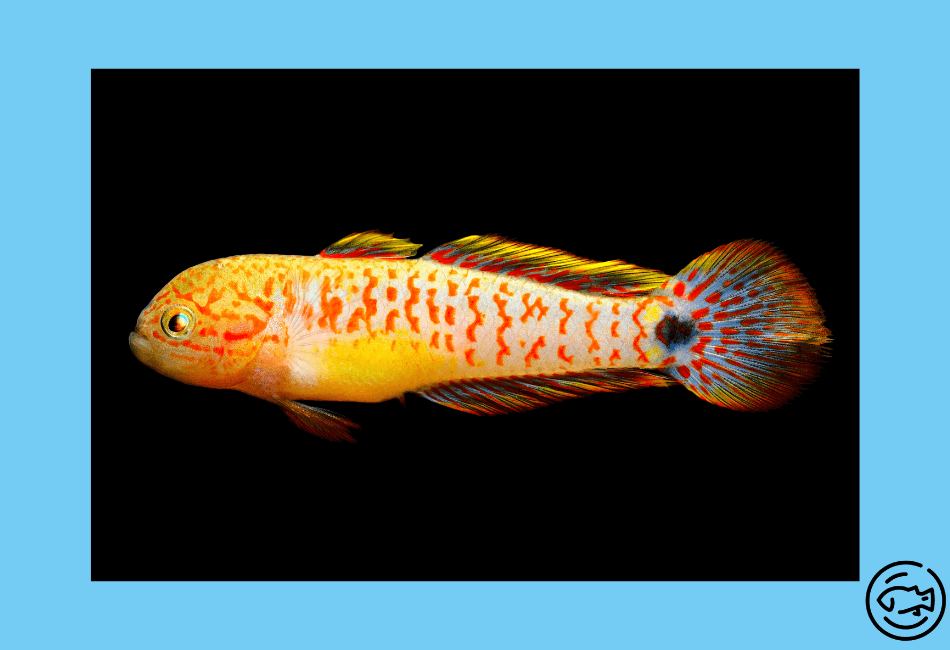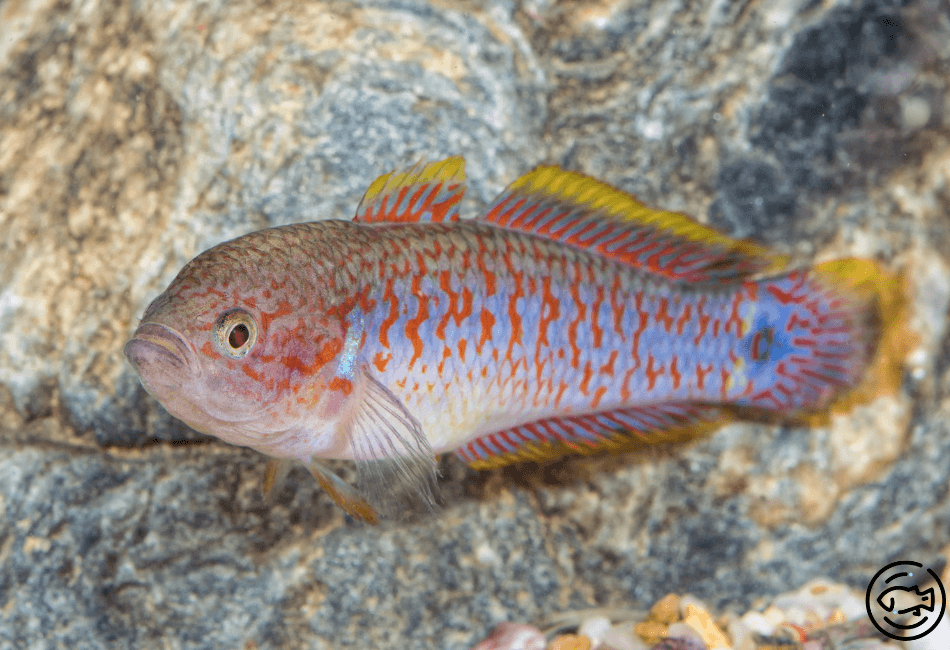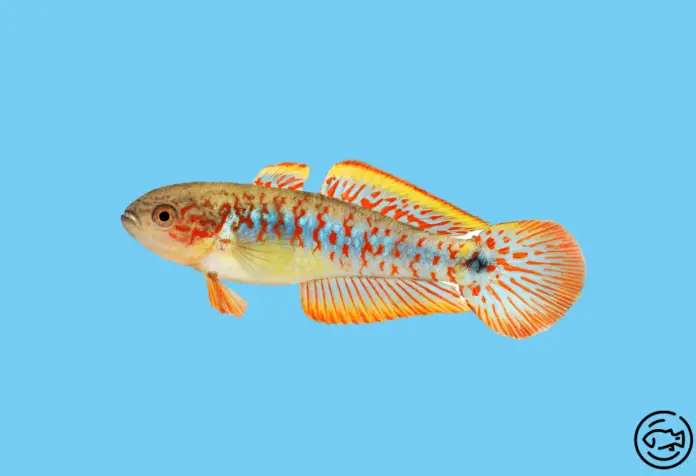The Peacock Gudgeon is a remarkably stunning and distinct freshwater fish that every aquarium enthusiast should contemplate.
These fish possess a striking appearance and are relatively simple to manage. They thrive without needing intricate conditions and coexist harmoniously with numerous other species.
This comprehensive manual on Peacock Gudgeon upkeep will equip you with all the essential knowledge for successfully nurturing this fish. Discover critical tank specifications, feeding habits, compatible tank companions, breeding advice, and much more!
Overview
The Peacock Gudgeon (Tateurndina ocellicauda) is a brilliantly colored freshwater fish native to shallow water habitats in Papua New Guinea. They can also be found in regions across New Zealand and Australia.
Often mistakenly called the Peacock Goby, these fish are not part of the Goby family. They are, in fact, members of the Eleotridae and represent the only species within the Tateurndina Genus.
Nowadays, the majority of Peacock Gudgeons available in fish markets are spawned in captivity. Their growing popularity within the aquatic community is attributable to their eye-catching appearance, which evokes the iridescence of peacock plumage.
These fish make fantastic additions to any communal aquarium. However, providing them with specialized care is important to ensure their continued health, vibrancy, and stress-free existence.
Lifespan
Under favorable conditions, Peacock Gudgeons typically live in captivity for 4 to 5 years.
Although their lifespan may not be as long as that of some other freshwater fish species, these captivating creatures are sure to make the most of their time in your aquarium. Boasting distinct personalities, they are not shy about flaunting their vibrant colors.
Ensuring the health and longevity of Peacock Gudgeons is contingent upon a dedication to proper tank maintenance.
As with any fish, they are susceptible to drastic environmental shifts. Subpar water conditions may considerably reduce their lifespan and expose them to various ailments.
Appearance

In terms of aesthetics, Peacock Gudgeons rank among the most stunning freshwater fish available. Their vivid hues contrast beautifully with natural aquatic landscapes, making them an excellent addition to aquarium ecosystems.
These fish possess elongated, slender bodies with rounded heads. Adult males may even develop a nuchal hump on their forehead, further accentuating the spherical shape. The most striking feature of Peacock Gudgeons is their color pattern.
Their bodies are typically adorned with a silvery-blue tint, which can vary in intensity from subdued to electric blue, depending on the individual fish.
A gentle yellow tone often graces the belly of these fish, while their sides are embellished with red dotted stripes that run vertically along the entire body length. This silver-blue and red coloration also extends to the fins, with an additional touch of yellow along the edges.
Female specimens also display a slender black stripe atop the yellow portion of their fins.
Peacock Gudgeons boasts a unique “eye spot” at the base of their tail fin, a large black mark that lends the fish its “Peacock” nickname. Males and females exhibit some physical distinctions that make them easy to differentiate. Males, as mentioned earlier, may develop a forehead hump, while females have a thin black stripe on their fin edges.
Additionally, females exhibit more vivid coloration on their bellies, with the yellow shade being more pronounced than in males. Male Peacock Gudgeons also tend to be slightly larger than their female counterparts.
Size
Peacock Gudgeons normally reach a reasonable length of about 3 inches, with females rising to about 2.5 inches.
Young fry often attains maturity between the ages of 6 and 8 months. At this particular moment, they will have effectively reached their maximum size, although some may continue to grow slightly larger in the following months.
Peacock Gudgeon Care

In contrast to many other fish species, caring for Peacock Gudgeons is comparatively simple. They are adaptable and can also thrive in community locations.
That said, it is crucial not to place them in just any random tank, as these fish necessitate meticulously designed habitats and consistent water parameters to maintain optimal health. Below are some essential care guidelines to adhere to.
Tank Parameters
Due to their diminutive stature, Peacock Gudgeons only demand limited space (making them exceptional freshwater nano fish). Additionally, they are not known for being avid swimmers, meaning an extensive swimming area is not a prerequisite for their well-being.
We advise a minimum tank capacity of 15 gallons to accommodate a small group of Peacock Gudgeons. Naturally, a more spacious tank is preferable if you intend to house a larger group or create a multi-species community aquarium.
While several online resources suggest a 10-gallon tank for these fish, our experience has shown that an extra 5 gallons can significantly enhance their overall contentment and health. Moreover, finding a suitable location for a 15-gallon tank remains relatively straightforward.
Water Parameters
pH levels: 6.0 to 7.5 (ideally, around 7.0)
Water hardness: 6 to 12 dKH
Water temperature: 72°F to 79°F
Peacock Gudgeons dwell in shallow waters in their natural habitat, often found in calm ponds or slow-moving streams. These aquatic environments are characterized by abundant vegetation and relatively warm temperatures.
It is essential to mimic their natural surroundings as closely as possible to promote the well-being of Peacock Gudgeons in captivity. The optimal water parameters for these fish are as follows:
Conducting regular water tests to ensure the stability of these parameters is crucial. It is worth noting that, in freshwater aquariums, parameter fluctuations can occur quite easily without being immediately noticeable.
Tank Requirements
As previously mentioned, Peacock Gudgeons flourish in densely aquascaped aquariums filled with plants.
When designing your tank, incorporate a diverse array of robust plants, such as water wisteria, Java fern, Anubias, and more. The greater the variety of plants, the more content your fish will be, and plants not only emulate their natural environment but also serve practical purposes.
Fish will seek shelter among the plants when feeling threatened and enjoy swimming through leaves during moments of leisure.
Given their frequent interaction with plants, it is essential to include sturdy aquatic vegetation, as delicate plants can be easily damaged. Consider using a dark sand substrate for planting, as it is safer for these fish than gravel.
Alongside plants, utilize rocks and driftwood to create numerous hiding spots and areas for exploration. For Peacock Gudgeons, it is also advisable to incorporate a cave system, which can be crafted from rocks, purchased as a manufactured setup, or created using a simple PVC pipe.
Ensure the chosen cave is spacious enough for the fish to enter fully, as these dark, secluded spaces are vital during breeding.
Regarding filtration and water flow, there are no specific filter requirements for Peacock Gudgeons, and ensure the chosen filter effectively cycles the tank and maintains low nitrate levels.
It is important to consider the filter’s outlet, as Peacock Gudgeons are not strong swimmers and are not accustomed to powerful currents in their natural habitat, and minimize water flow by avoiding strong pumps or forceful air bladders.
To further reduce the current produced by the filter outlet, direct it against the tank glass or place large decorative items in front of it. This will help keep the water relatively still, better suiting the needs of your Peacock Gudgeons.
Diet
Feeding Peacock Gudgeons can be a bit challenging, as they tend to be rather selective eaters. In their natural habitat, they usually consume insects, larvae, and small creatures that provide them with ample protein.
Some aquarium enthusiasts have had success with high-quality dry food; however, Peacock Gudgeons generally prefer live or frozen meals. While you can experiment with dry food, it’s advisable to supplement their diet with live food to ensure their well-being.
Options such as brine shrimp, bloodworms, daphnia, and other nutrient-rich live foods will help your fish thrive. Not only will they be more content, but their colors may also become more vivid when consuming live foods.
Behavior
Peacock Gudgeons are generally peaceful creatures and tend to get along well with other non-aggressive fish of similar size. They are happiest when living in a group, and while they can be held in pairs, they truly thrive in larger groups of 6 to 8 fish.
Mild aggression may occasionally occur between males in a group, but it is usually harmless. They may engage in brief sparring matches before moving on without lasting harm to the fish.
These fish often enjoy exploring their surroundings and interacting with aquatic plants. When they feel at ease in their environment, you may even observe them swimming in open areas, proudly displaying their stunning appearance!
Tank Mates
Numerous Peacock Gudgeon tank mates are available for you to choose from. Besides the fish of the same species, Peacock Gudgeons generally get along well with most other peaceful fish.
You can house them in community tanks, provided there are no significant aggressors. It’s possible to keep moderately territorial fish in the same tank but ensure they are not large enough to prey on the Peacock Gudgeons. Also, having a bigger tank is crucial so that any territorial fish can have their personal space.
Some individuals may wonder if shrimp make suitable tank mates for this species. From our observations, it’s best to avoid Cherry Shrimp, but Ghost Shrimp might be an appropriate option.
Below are some appropriate tank mates for the Peacock Gudgeon:
- Cory Catfish
- Bumblebee Goby
- Harlequin Rasbora
- Kuhli Loach
- Ember Tetra (or other Tetras)
- Cherry Barb
- Celestial Pearl Danios
Breeding
Breeding Peacock Gudgeons is relatively easy, and these fish generally form pairs rapidly. When you have a sizable group of fish, identify a pair and relocate them to a separate breeding tank for safety.
Ensure that your breeding tank has a cave or similar structure. You could use a PVC pipe, an artificial cave, or a terracotta pot.
Initiate the breeding process by conducting a water change and offering the bonded pair an abundance of protein-rich live food. When the male is prepared to breed, he will dance with the female, swimming around the cave system’s entrance and displaying his pectoral fins.
If the female accepts the invitation, she will enter the cave and lay between 50 and 100 eggs. These eggs are sticky and may be deposited on the cave walls or ceiling, and once she has finished, she will exit the cave.
The male then takes responsibility for the eggs, and he will fertilize and care for them during incubation, fanning the eggs and fiercely guarding the area.
The eggs will hatch in around 8 to 10 days, and the male may stay for a short time to ensure the fry consumes the eggs, but eventually, he will leave the young fish to survive on their own. At this point, you can remove the adult male and female from the tank.
The growth of baby Peacock Gudgeons is relatively slow.
Feed them infusoria and powdered food until they can eat baby brine shrimp. It will take several weeks for them to become free-swimming, so closely monitor their progress and continuously provide food to support their growth.
Diseases
Peacock Gudgeons can be susceptible to a variety of diseases that affect fish in general rather than being exclusive to this species.
Ich is a common issue caused by the ectoparasite Ichthyophthirius multifiliis. Stress often makes freshwater fish more vulnerable to this parasite, so maintaining optimal water conditions and a well-kept tank is crucial.
Ich is highly contagious, requiring the quarantine and treatment of infected fish with copper-based medications.
Peacock Gudgeons may also suffer from Hole-in-Head disease, which typically affects larger fish like Cichlids but can also impact Peacock Gudgeons. This condition is spread through feces and often results from poor water quality, causing sores and noticeable pits on the head.
Worms and parasitic infections, such as anchor worms, can attach to the fish’s head and body, prompting them to “scratch” against decorations. Similarly, skin and gill flukes are tiny worms that latch onto fish, creating small lesions.
While minor infestations may not be life-threatening, larger ones can prove fatal for Peacock Gudgeons. Fortunately, these issues can often be treated with antifungal and antibacterial medications.
The most effective strategy for preventing these diseases involves maintaining excellent water quality and being cautious not to introduce contaminants or other species carrying diseases into the tank. By remaining diligent, dedicated, and careful, you can likely prevent these diseases from affecting your fish!
Conclusion
Upon completing this guide, it’s evident why we hold these fish in such high regard. Their captivating beauty, low-maintenance care, and engaging nature make them truly special.
Please reach out if you wish to expand your knowledge about this species or have insights you’d like us to incorporate into this page!
We strive to create the ultimate Peacock Gudgeon care guide online, and any additional contributions are welcomed.



